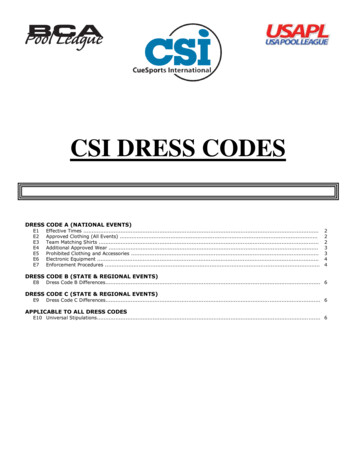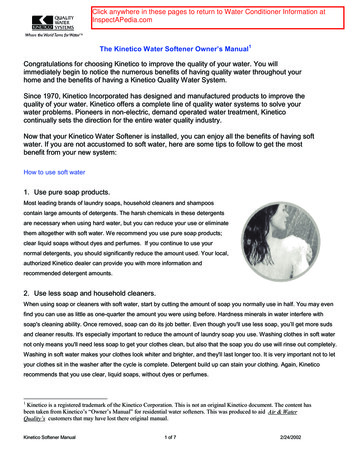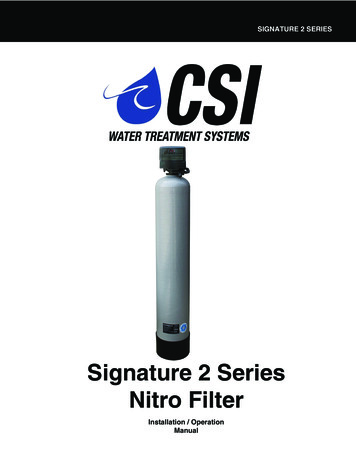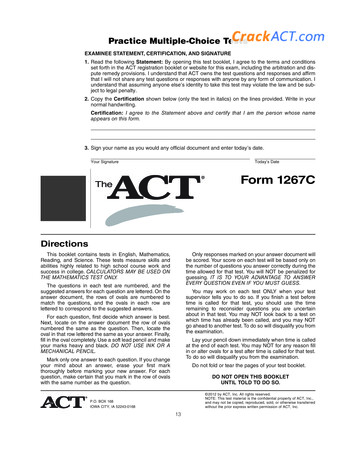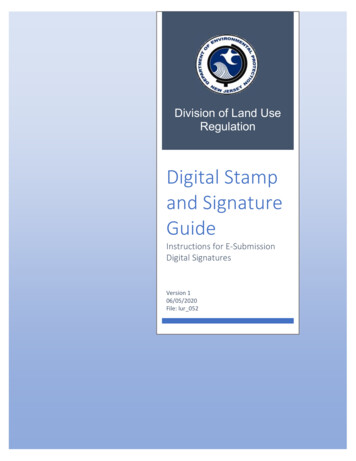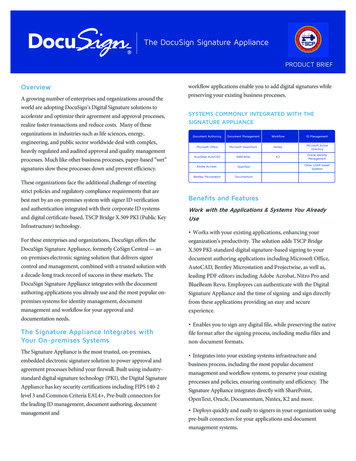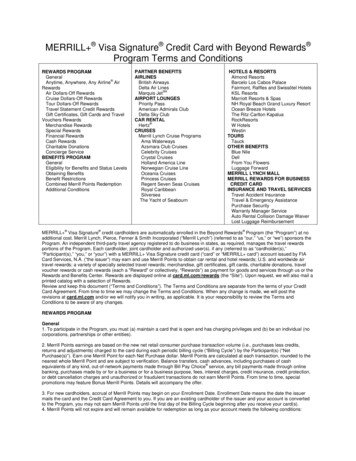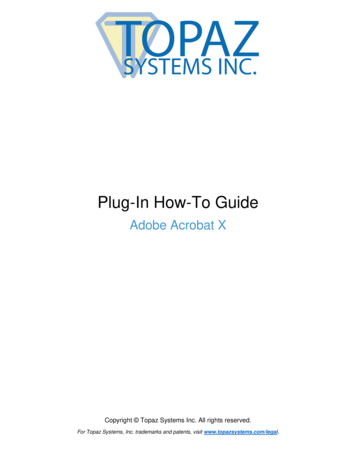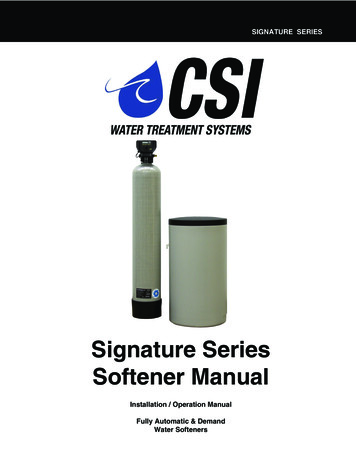
Transcription
SIGNATURE SERIESSignature SeriesSoftener ManualInstallation / Operation ManualFully Automatic & DemandWater Softeners
SIGNATURE SERIESSoftener Specifications.Page 3Softener Installation.Page 5Softener Capacity.Page 10Control Start Up Procedures.Page 12
SIGNATURE SERIESSoftener SpecificationsWARNINGLubricantsDo NOT use Vaseline, oils, hydrocarbon lubricants or spray silicone anywhere! Petroleum base lubricants willcause swelling of o-rings and seals. The use of other lubricants may attack plastic Noryl . It is recommended thatDow Corning silicone grease be used as a lubricant for all control valves. Dow Corning 7 Release Compoundis used in the manufacture of Chandler Systems control valves. (Part # LT-150)SealantsPipe dope and liquid thread sealers may contain a carrier that attacks some plastic materials. It is recommendedthat Teflon tape be used to seal plastic Noryl threaded fittings.PLEASE NOTE THESE SPECIFICATIONS BEFORE PROCEEDINGOPERATING PRESSURE RANGE : 20 - 125 PSIOPERATING TEMPERATURE RANGE : 33º F - 120º FINLET / OUTLET PIPE SIZE : 3/4: FNPTPLEASE COMPLY WITH ALL APPLICABLE PLUMBING CODESPROTECT THE SOFTENER AND PIPING FROM FREEZING MS128V24,000 / 1220,250 / 7.515,000 / 4.532,000 / 1527,000 / 920,000 / 648,000 / 2440,500 / 1530,000 / 964,000 / 3054,000 / 1840,000 / 1296,000 / 4581,000 / 2760,000 / 18128,000 / 60108,000 / 3680,000 / 24Maximum Raw Water Hardness (grains)5075100100100100Maximum Clear Iron / Manganese355555.751.01.52.03.04.0Mineral Tanks (polyglass)8 x 449 x 4810 x 5412 x 5214 x 6516 x 65Brine Tank (polyethylene w grid & safety)18 x 3318 x 3318 x 3318 x 3318 x 4024 x 50Service Flow Rate (gpm per active tank)*8.010.011.012.014.016.0Backwash Flow Rate (gpm)1.52.02.43.54.05.0Gallons Used / Regeneration7990101140164189Backwash Flow Rate (gpm) Vortech (V) Units1.21.52.02.43.540General SpecificationsGrains Capacity Regeneration / Lbs Salt Used**Exchange Resin (cu ft per tank)Gallons Used / Regeneration Vortech (V) UnitsSpace RequiredApproximate Shipping Weight (lbs)69789011714816118x26x5318x27x 5618x28x 6218x30x 6018x32x 7424 x 40 x 74881001331642853783
SIGNATURE SERIESSoftener SpecificationsPlease read the entire Owner’s Manual and Instruction before installation.This Owner’s Manual must stay with the unit.How A Water Softener WorksWater hardness is derived from Calcium and Magnesium minerals that have been dissolved into the water under theearth’s surface. These minerals are found in limestone deposits and are the source of hard water. The amount of hardness in a given water supply is dependent upon the quantity of Calcium and Magnesium present and the length of timewater has been in contact with them. This can vary dramatically from well-to-well and, for this reason, a water analysis isimperative in order to determine the proper treatment method. The degree of hardness increases as the concentration ofCalcium and Magnesium “ions” increase and is measured in Grains Per Gallon (gpg).The problem of hard water in the home / business comes to light in many facets of daily use. Water spots and scum leftbehind on bathtubs, fixtures and showers; wear and tear on appliances; calcium build-up in hot water heaters and piping;and, greater amounts of soap and detergents being used are just a few examples.The modern water softener is designed to reduce hardness ions and their unpleasant side effects. Special resin beadsin the softener mineral tank are used to change hard water into soft water. The surfaces of these beads are covered withsodium ions. As hard water enters the mineral tank and comes into contact with the resin, an exchange of ions takesplace as dissolved Calcium and Magnesium ions cling to the resin surface and sodium ions take their place, thus softening the water. This process is called Ion Exchange. Over time, the sodium ions used for the exchange process becomedepleted and must be replenished.The water softener provides a Regeneration process whereby brine solution enters the mineral tank, driving-off thecollected hardness ions and replenishes the surface of the resin beads with more sodium ions. This process isautomatically initiated by the control valve on the mineral tank. The regeneration process has five basic cycles as follows:1. Backwash - The control valve directs the water flow in a reverse direction through the mineral tank, separating theresin beads and flushing any accumulated particles to a waste drain.2. Brine & Rinse - In the first part of this cycle, the control valve directs brine solution downward through the mineraltank, driving-off collected hardness ions and replenishing the resin beads with sodium ions. The second part of thecycle rinses hardness ions and excess brine from the mineral tank to the waste drain.3. Rapid Rinse - The control valve directs the water flow downward, settling and recompacting the resin bed.4. Brine Refill - The control valve directs fresh water into the salt compartment to create new brine solution for the nextscheduled regeneration.5. Service - This is the normal “operating” cycle where hard water enters the mineral tank, comes into contact with theresin beads and exchanges hardness ions for sodium ions - the water then becomes “soft” and ready for use.Pre-Installation Check ListA water test should always be performed in order to determine total water hardness (in gpg) and total dissolved iron (inparts per million - ppm). This is critical for proper equipment selection, sizing and for determining the program for regeneration frequency. If heavy concentrations of iron (above 5 ppm), iron coloration, iron bacteria or sediment are present,filtration prior to the softener will most generally be required. Certain states may require a licensed plumber for installation.Note : Flexible water supply connectors and flexible drain line tubing may not be allowed in you locale. Please check withlocal plumbing code officials prior to installation.4
SIGNATURE SERIESInstallationInstallation Requirements A level floor position ahead of piping into water heater. Unit must be installed at least 10’ ahead of the inlet to a water heater to prevent damage due to back-up of hot water. DO NOT install the unit in an area of direct sunlight or where freezing temperatures may occur!(See Installation Diagrams for proper placement and plumbing connections.)Major System Components1. Brine Tank - This tank holds the salt that is added to the softener. This salt is dissolved with water to form a brinesolution used in the softener regeneration process.2. Resin Tank - This tank contains the ion exchange resin media. Water flows through the resin tank under pressure tocome into contact with the resin for water softening.3. Control Valve - The valve directs water through the resin tank for water softening and controls the flow of water / brinefor the regeneration process.5
SIGNATURE SERIESInstallation-Softener Location / Other Requirements Locate the unit near an unswitched, 120 volt / 60 Hz grounded electrical outlet. Check for distance and proper drain installation (e.g. floor drain, washing machine standpipe). Determine type and size of piping required for softener connection (e.g. copper, galvanized, PVC plastic).Note If household plumbing is galvanized and you intend to make the installation with copper (or vise versa),obtain di-electric unions to prevent dissimilar metal corrosion. Where the drain line is elevated above the control valve or exceeds 20 feet in length to reach the drain,use 3/4" I.D. drain line tubing instead of 1/2" I.D. Drain line tubing is not included. All plumbing lines not requiring “soft” water should be connected “upstream” of the softener. The brine tank drain line is gravity flow and must discharge below the overflow fitting. The brine overflow is provided as a back-up in the event the safety float shut-off should fail, allowing the brinetank to overfill. This drain connection would then carry the excess water to the drain and prevent flooding ofthe floor. Therefore, no liability will or can be assumed by the manufacturer of the softener should this occur.Caution If sweat soldering copper pipe (remember to always use lead free solder and flux), cover bypass valve withwet rags to prevent heat damage to connections and control valve! If using PVC or plastic pipeprimers and solvent cements specifically recommended for use with potable water are required. Do not “TEE” to the main drain line from control valve.6
SIGNATURE SERIESInstallation-Installation Procedure- Water Supply Connections and Bypass Valve To allow for softener servicing, swimming pool filling or lawn sprinkling, a manual bypass valve has been installedat the factory. The bypass allows hard water to be manually routed around the softener.1. Position softener at desired location for installation. (See Installation Diagrams.)2. For TS96V, TS128V, MS96V, & MS128V Units ONLY - The resin material is shipped separately from the mineraltank. Remove the valve by unscrewing from center hole. Use a cork or tape to place over top of distributortube to prevent material from entering tube while filling. Place funnel in hole. Pour several gallons of water in thetank.No gravel is required. Pour in the resin material. Remove funnel and cork or tape from distributor tube. Cleantank threads and fill the mineral tank completely with water. Replace the valve, being careful to position thedistributor tube into the distributor tube pilot hole.Note: If rebedding an existing unit and the system utilizes a standard tube & basket style distributor, a “D” gravelunderbedding will be required.3.Turn OFF main water supply and OPEN nearest faucet to relieve pressure.4. Cut main line and install appropriate elbows and extensions. Inlet and outlet connections on the control valve are3/4” FNPT. (1” FNPT for TS96V, MS96V, TS128V & MS128V units.)Caution : Raised arrows located on the sides of control valve body and bypass valve indicate proper direction of waterflow. Install inlet and outlet piping in direction of arrows.5. Rotate bypass valve lever to the bypass position (position of lever is perpendicular to the inlet / outlet piping).6. Turn the main supply line on to restore water service to the home.7. OPEN nearest faucet to evacuate air and repressurize plumbing lines.8. Check for leaks!-Drain Line Connection1. Pull out clip and remove drain line assembly located on the left side of control valve. Remove drain line hose barband wrap threads with Teflon tape. Reinstall drain line hose barb. Caution : Hand tighten only!!! Replace drain lineassembly and reinstall clip.2. Install 1/2” I.D. drain line tubing (not included) from hose barb to an open drain. A 4” gap between the end of thedrain line and the open drain is required to prevent waste water backflow. Keep the drain line as short as possible.An overhead drain line can be used if necessary, but should discharge below the control valve. A syphon trap(taped loop) at the outlet of the drain line is advisable to keep the drain line full and assure correct flow duringregeneration. Elbows or other fittings must be kept at a bare minimum.Note : Where the drain line is elevated above the control valve or exceeds 20’ in length, 3/4” I.D. drain line tubingshould be used.7
SIGNATURE SERIESInstallation-Brine Line and Overflow Connection1. Position brine tank on a smooth, level surface near the softener resin tank. If necessary, the brine tank can beplaced at a higher level than the resin tank, but never at a lower level.2. Install one end of 3/8" O.D. by 1/4" I.D. brine line tubing (included with unit) to compression fitting located on left sideof control valve.3. Remove brine tank cover.4. Remove cap from brine well.5. Insert opposite end of brine line through outer hole in brine tank.6. Connect brine line to push lock fitting on safety brine valve located inside brine well. Replace brine well cap.7. Install 1/2" I.D. drain line tubing (not included) to the overflow fitting on brine tank located just below the brine line.8. Run the opposite end of brine tank drain line to a suitable drain.Note :The brine tank drain line is gravity flow and must discharge below the overflow fitting.Caution : Do not “TEE” to the main drain line from control valve.Notice : The brine overflow is provided as a back-up in the event the safety float shut-off should fail, allowing the brinetank to overfill. This drain connection would then carry the excess water to the drain and prevent flooding ofthe floor. Therefore, no liability will or can be assumed by the manufacturer of the softener should this occur.- Electrical Connection 1. Connect the power cord and plug power supply into a 115 volt / 60 Hz receptacle.Note : Do not plug into an outlet controlled by a wall switch or pull chain that could inadvertently be turned off1. Remove the rear cover.- Installing Battery Back-Up -2. Install a 9 volt battery. Refer to page 3, item 3 of the Signature Series Service Manual.3. Reinstall rear cover.8
SIGNATURE SERIESInstallation- Pressurizing The System 1. Make certain Signature Series Control Valve is in SERVICE position.2. Slowly rotate bypass valve to the SERVICE position.3. Open the nearest faucet to evacuate air from plumbing lines.4. Check for leaks! If water is observed leaking from bottom of bypass, close and open bypass lever several times toseat o-rings.5. After air is
The modern water softener is designed to reduce hardness ions and their unpleasant side effects. Special resin beads in the softener mineral tank are used to change hard water into soft water. The surfaces of these beads are covered with sodium ions. As hard water enters the mineral tank and comes into contact with the resin, an exchange of ions takes
